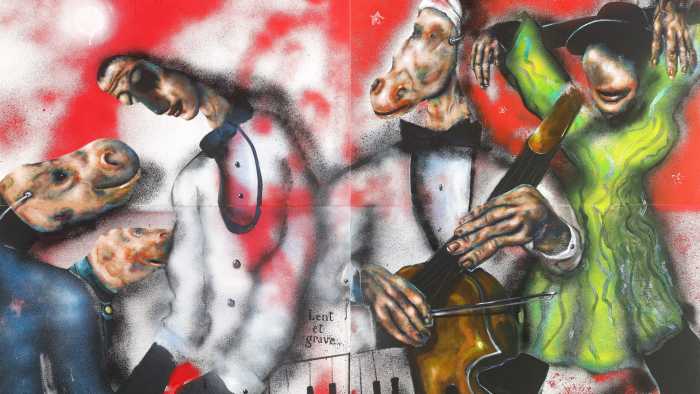By Steven Snyder
Three innovative takes on war premiere at Tribeca
A growing cadre of renegade filmmakers are traveling overseas and returning with stories that reshape the way Americans see the Iraq war, far beyond the conflict’s traditional media coverage. Three of the latest Iraq documentaries will premiere side-by-side at this year’s Tribeca Film Festival, each chronicling the stories of American soldiers, veterans and Iraqi insurgents with an intimacy that no other film or television documentary has yet captured.
“Sure, my film is offering people a perspective they haven’t seen elsewhere, but really what’s more interesting is that most of us here in America aren’t being given any perspective,” said Andrew Berends, director of “The Blood of My Brother,” a documentary that follows the lives of one Iraqi family as it copes with the loss of a son, and how that man’s brother flirts with joining the growing insurgency against America to exact revenge.
“I was at a store in December of 2003 – eight or nine months after the invasion – and I remember that people were Christmas shopping, listening to holiday music and I thought: This is what war looks like to Americans,” he said. “We hold it at such a distance here, but for Iraqis you can’t make that choice.”
For Berends and numerous other filmmakers, the antidote to that distance was immersion, living alongside American soldiers and Iraqi citizens in a countryside that is now infamous for kidnappings and beheadings. And while Berends’ film is not the first Iraqi documentary to hit movie theaters, it goes beyond the embedded mindset that limited such films as “Gunner Palace,” and adds to the short-term perspective of such documentaries as 2004’s “Voices of Iraq,” which finished filming long before the insurgency intensified later that year.
Living with his Iraqi subjects, capturing their lives while in battle, in prayer and while coping with death, Berends considered himself the antithesis of the embedded American reporter. In “The Blood of My Brother,” he joins Iraqis as they roam the countryside, seeking revenge against U.S. military targets, and rides atop a rumbling tank.
“My approach is to get as close as possible to what’s going on,” Berends said. “If it’s fighting or if it’s grieving, I wanted to be right next to the fight, as close as I could get to actually touching them.”
If Berends’ film represents an attempt to document daily life in Iraq, and the toll the war has taken on those who call the country home, Richard Hankin’s “Home Front” is a chronicling of the little-discussed toll it’s taken on the American soldier.
The subject of “Home Front” is Jeremy Feldbusch, a 21-year-old marine who was severely wounded only four months after landing on Iraqi soil in 2003. Impaled in the head by shrapnel that found its way around his protective goggles, Feldbusch was left blind and confined to a hospital bed. The story of “Home Front” is how his parents, without help from the military, come to rally behind their son and how Feldbusch himself comes to deal with his disability.
Both “The Blood of My Brother” and “Home Front” explore the aftermath of war, but “The War Tapes” uses one of the most innovative techniques to capture the reality of the war experience.
Pulling together an acclaimed team, including Robert May, producer of the Academy Award-winning documentary “The Fog of War” and Steve James, director, producer and co-editor of the hailed 1995 doc “Hoop Dreams,” “The War Tapes” is an unconventional war story documented in an unconventional way. May said it seemed strangely appropriate that he only came to such an unusual experiment by chance.
“Deborah Scranton, who directed the film, literally cornered me at a cocktail party,” he said, recalling their first encounter at the 2004 Sundance Film Festival. “I felt a little afraid, actually, but the more she told me about her idea, the more she sold me.”
Scranton’s idea was deceptively simple: To tell a linear, first-person story of how war affects both the psyche of a soldier from touchdown to liftoff, as well as the lives of those they love, who wait for news on the other side of the globe.
But the only way to tell a story like this, May said, was to “embrace a new kind of citizen journalism that had before been attempted.” Giving three national guardsman digital cameras before they left for war, and consulting with them in Iraq via instant messaging after viewing the footage they mailed home, Scranton helped each man capture his version of the Iraq experience while she visited each man’s family to capture the hometown perspective.
The results, May said, were fascinating, evolving both as a story of men trapped between worlds and a tale of survival under the most stressful of conditions.
“I don’t know anyone in the service, I don’t think many people do,” May said. “But I started worrying if they would be all right — both physically and mentally. It was more about the human and less about the war.
“In the beginning, when they got the cameras, they were joking around a lot but later you realized that these guys were fighting to stay alive during the day and then at night are trying to check in with their families and stay up to date with what’s going on at home.”
May said he a saw remarkable change in the film’s subjects through the thousands of hours of raw video that poured into his New York City production office. He said for him, it was the beginning of understanding the “human cost” that lies behind the politics and the rhetoric of the everyday war debate.
The more footage he saw as the months ticked by, the more May said he realized that this is a story that needs to be seen by others who have endured this experience.
As part of their grass-roots campaign to connect soldiers and their families with the film — a mission May said he is passionate about, given how many soldiers have related to the struggles endured by these three guardsman — the filmmaking team launched thewartapes.com, a site that not only features information on this documentary, but also hopes to serve as a forum for soldiers from the past, present and future to share their experiences.
“The Web site is not just advertising, it’s the epicenter of the film,” May said. “It will be a repository for other war footage, whether World War II or Vietnam, and it hopefully will become the place for people to go to deposit films about war so the community can really know what it’s like.
“There may always be war, but when people can see what real war does to people and what the human cost really is, hopefully we’ll get into war less easily.”
WWW Downtown Express































